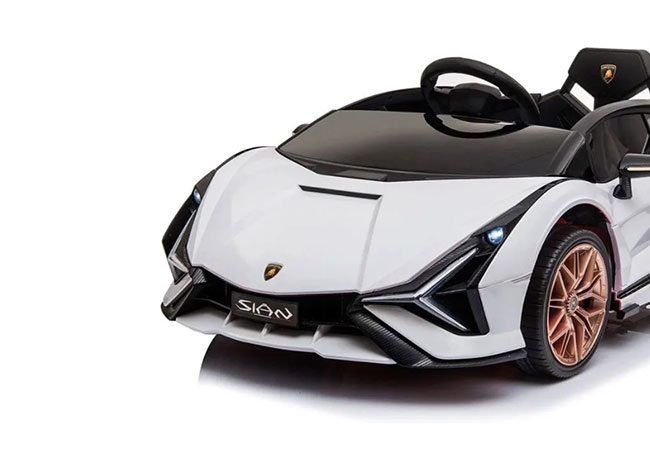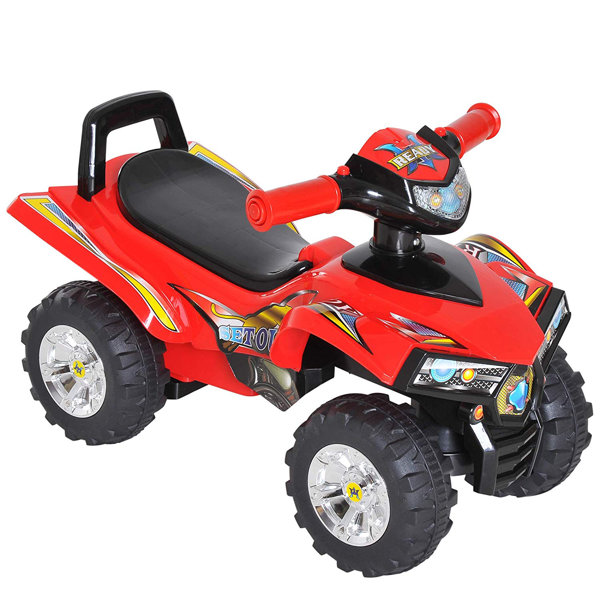Knowing the battery type and charging time of a kid's electric ride-on car is essential to ensure optimal performance and uninterrupted playtime. This article will provide you with all the information you need to know about the type of battery.
The majority of electric vehicles designed for children use rechargeable batteries, usually lead-acid or lithium-ion batteries. In general, rechargeable lithium-ion batteries provide an extended battery life as well as quicker charging times than lead-acid batteries.
Battery Capacity
The battery capacity, measured in ampere-hours (Ah) or Watt-hours (Wh) will determine the length of time that a ride-on vehicle can operate on a single charge. Batteries with a higher capacity allow for a longer play time before needing to recharge.
Run Time -
The runtime of an electric car is how long the vehicle can run continuously on only one charge of battery. This is influenced by a variety of factors, including battery capacity, strength of motor, the terrain, or weight of the driver.
Common electric ride-on vehicle run times vary from 30 minutes and two hours per charge. Batteries with a large capacity may provide a longer run time.
Time to charge -
The charging time is how long it takes the battery to completely recharge once it's been depleted. Charge times differ based on battery capacity, charger specs and charging methods.
The average charging time of electric ride-on vehicles is 8-12 hours. However, some models may have faster charging times, especially equipped with lithium-ion batteries.
To ensure safety and long-lasting battery life, it's important to charge the battery according to the manufacturer's instructions. Battery performance could be adversely affected if the battery has been overcharged or undercharged.
Charge Methods Charge Methods
The majority of electric ride-on vehicles come with a charging cord that plugs directly into a standard outlet. Certain models might have quick charging or even an intelligent charger that monitors the battery's status of charge and adjusts the charging speed accordingly.
To ensure that there is no damage to the battery or electrical system Make sure the charging connector and port are compatible with the chargers that come with your ride-on vehicle.
Additional Batteries
Some electric ride-on vehicles may permit you to purchase additional batteries or spares for a longer time of play. You can replace the worn-out batteries with ones fully charged, which means you can reduce the duration between sessions.
Knowing the battery's charge time of a kid's vehicle will ensure that both you and your child can enjoy uninterrupted and fun playtime as well as thrilling adventures. Continuously charging the battery and following appropriate charging guidelines will to extend the life of your battery and improve its performance. Check out the recommended JCB ride on toys for site advice including car for toy, car on ride, toy the car, childrens electric ride on, electric car ride, race car toy, childrens electric ride on, electric rideons, childs electric ride on car, toy the car and more. .

What Maintenance And Assembly Is Required For The Kid's Car Ride-On?
The ride-on vehicles for kids typically need periodic maintenance and assembly to ensure maximum performance security, longevity, and safety. Here are the most common maintenance and assembly requirements for kids' rides-on-cars.
The majority of cars that ride on are assembled in a way and require some sort of assembly. Attaching the wheel, steering wheel, seats and other accessories to the ride-on vehicle according to the instructions of the manufacturer is the most common method.
Follow the assembly guidelines closely to ensure that every component is correctly aligned and securely secured. Make use of the tools and hardware to complete the assembly.
Cleaning -
The cars that ride on them need to be cleaned frequently to ensure that they look their best and function correctly. Use the soft, dampened sponge or cloth with mild soap and warm water for cleaning the exterior of your.
Be mindful of areas that are susceptible to buildup including the wheels, tires and undercarriage. Make use of a toothbrush or a brush to scrub hard-to-access areas and eliminate stubborn grime.
Do not use harsh cleaners or water jets that have high pressure which could harm the electronic and paint components on the car.
Battery Care
It is essential to maintain the battery if your ride-on vehicle is powered by a battery which can be recharged. This will help maintain the performance of your battery and extend its battery life. Here are some suggestions for taking care of your battery.
Make sure to fully charge your battery prior to the first use, and then every time you make use of it, to ensure maximum running time.
Beware of overcharging and not leaving the battery in the charger for long periods of time. This can cause damage to the batteries and reduce their life span.
When not in use make sure to keep the battery and cars in a place that is dry, cool, and away from intense temperatures and direct sunlight.
Inspect the battery terminals regularly for signs of damage and corrosion. Clean with a terminal cleaning tool or wire brush, if necessary.
If the battery stops charging or has signs of wear, replace it.
Tire Maintenance -
Always check your tires for signs that they're losing air pressure, damaged or worn. Inflate the tires to the recommended pressure with a bicycle pump or air compressor as needed.
Look for debris and foreign objects within the tread pattern, which could cause punctures. Removing obstructions, and replacing damaged tires or fixing them if necessary.
Lubricate wheel bearings and axles frequently to decrease friction and ensure smooth rotation.
Sometimes, repairs or replacements are needed
Even with regular maintenance, it is likely that the ride-on vehicles need to be fixed or replaced with parts due to wear and tear or accidents.
Check for indicators of degrade or malfunction for example, a weird sound and erratic behavior or power loss. Contact customer support or follow the manual of the manufacturer for help for troubleshooting.
Replace worn-out or damaged parts promptly to prevent further damage and ensure the safety and functionality of the ride-on car.
Follow these assembly guidelines as well as maintenance guidelines will ensure that your child has hours of fun, safe playtime. View the top rated click here on kids cars for site info including ride electric car, toy a car, ride on digger, ride electric car, race car toy car, 2 seater electric cars, kidscars, pedal car, toy in car, lambo toy car and more. .

What Should I Look For Prior To Purchasing A Children's Electric Car? What Are The Pros And Cons?
Before you purchase an electronic kids vehicle, there are several factors to consider to ensure that you select the best car for your child's needs and needs. Below are a few important factors to take into consideration as well as information on sizes, prices and pros and cons.
Consider the size and age of your child's when selecting the best electric car for your child. The size and the age of your child will decide the model and type you choose.
Car size and weight -
Children's electric cars are available in a variety of sizes. They range from miniscule to full-size replicas. The size and weight of the car your child is driving should be based on the age of your child, their size and capacity. Also, consider the space available for storage and play.
Price Variation
The prices of electronic kids' cars can vary widely depending on factors such as the size, features, brands, and the build quality. Micro-sized models are generally more affordable, with prices ranging from $50 to $200. On the other hand, larger-scale models can range from $200-$800 or more for top-quality replicas that are licensed.
Pros and cons -
Pros -
Electronic Kids' Cars - These cars are great for fun and games that are imaginative. Kids can experience the thrill of having their own vehicle.
Motor Skill Development - Operating an electric vehicle can help children to develop coordination, spatial awareness, and fine motor skills.
Electric cars encourage outdoor play, physical exercise and exploration.
Realistic Features- A lot of electric children's cars come with realistic features like working headlights as well as horn sounds. They also support MP3 players which can enhance the experience.
Cons
Cost - The most high-end electronic children's vehicles, particularly replicas licensed from popular car brands could be costly.
Battery life – Electric vehicles use rechargeable batteries that power their motors however, these batteries can have limited runtimes and require frequent recharging.
Safety Issues Electric cars are prone to safety hazards including accidents, falls, and traps. This is especially true when the vehicle is not operated with caution and under adult supervision.
Maintenance and assembly - Some electric vehicles require assembly prior to arriving and regular maintenance. This includes cleaning, battery care and periodic repairs or replacements.
Accessories and Features
Take a look at the features and accessories available for your electric kids' cars such as horns that function as well as storage compartments, seatbelts and remote controls for parents. Choose a car with features that match your child's preferences and interests.
The final decision on the best electric kids' car for your child is based on factors like their size, age, interest, and your budget. Research, compare the models review them, and consider the pros and cons before making your decision. Follow the best ride on toys kidscars.co.uk news for blog examples including childs ride on car, childs electric ride on car, electric rideons, ride of car, remote control childrens electric cars, race car toy, ride on digger, car electric ride on, toy a car, electric rideons and more. .
